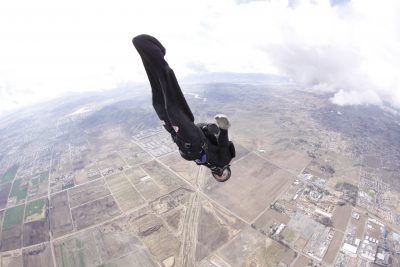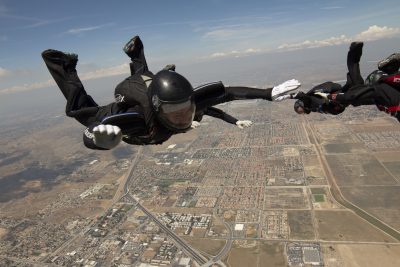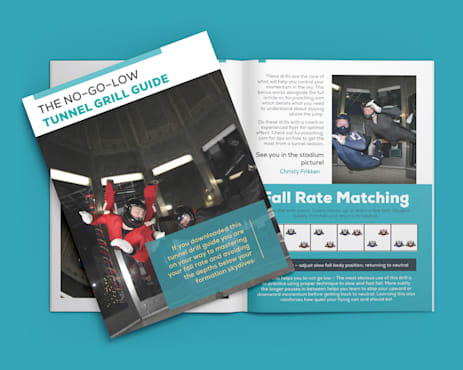Tracking Body Position
Monday, July 19, 2021

- Christy Frikken
- 7/19/21
- 0
- General
Get away from that group! Want to boogie faster and further away at the end of your skydive? Check your technique.
Flat vs. Steep
A flat track is a good track. Flat means you are falling slowly and going forward a lot. Your angle relative to the horizon is flat.
A steep track is sadness. Steepness means you are falling quickly but not moving forward as much. It is dangerous because you might not get enough distance from your fellow jumpers before deployment.
Flat and Steep Feel Similar
For the person tracking, flat and steep might feel the same. It can feel like your body is doing the same thing in both cases. This similar sensation is why many bad trackers aren’t aware they have an issue until someone brings it up.
|
|

|
A steep tracker is usually doing ok at the forward bit, but failing on the slow fall part.
Up and forward
The essence of a flat track is slow fall and forward. The slower you fall, the more time you will have to fly forward and away from the group. You are going “up” and forward at the same time.

Three big parts
When you see this picture, it is tempting to snap into this shape. Unless you have mastered the position, that doesn’t work and results in an almost head down angle.
Take your time and move into this position in phases. If you wobble or go head low, ease up until you get back on track.
Torso
Your torso is the most significant factor in your track. Getting flat is what causes you to slow fall – so de-arch until you are a giant flat board. All of the things that make an excellent slow fall help – push your chest and hips onto one long line. Don’t go past flat to stick your butt in the air!
Legs
Now that you are slow falling, add stronger legs to go forward. Your legs should stick straight out from your body. Your knees don’t have to be all the way together like the crisp, perfect track picture while you are learning; keep a little space for stability.
Again, if you feel wobbly or notice your head dipping, ease back to the torso step and reapply the knees.
One common problem is locking your knees but not pushing your legs down onto the wind. You can have ‘straight’ legs relative to your hamstrings but your whole legs are still angled upward. You have to push down with straight legs to push your body forward.
Arms back and pressing
After you have your torso slow falling, and your legs drive you forward, add some arms. Having arms tight to your sides is challenging at first – so keep them wider until you feel the balance. The arms should be at or below the hips while pushing against the wind.
Chin roll
As a bonus, be sure to tuck your chin inwards and ‘roll’ your shoulders. This pushes your chest entirely into the wind and adds lots of slow fall.
Tunnel drills
You can’t practice this entirely in the tunnel – but there are components to try. Get good at going upwards and slow falling simultaneously. Up and forward is the same motion you are making at the start of your track.
You can also practice the shoulder roll by maintaining fall rate while putting both hands behind your back. It is a challenging but fun trick!
The next time you track away, pay attention! Flatten out your track by moving in stages, focusing on the torso, legs, and arms in order. If you get wobbly, rewind, and reapply the technique. Go far and fast!
For an additional excellent tutorial, check out Rhythm’s Instructional Series.





